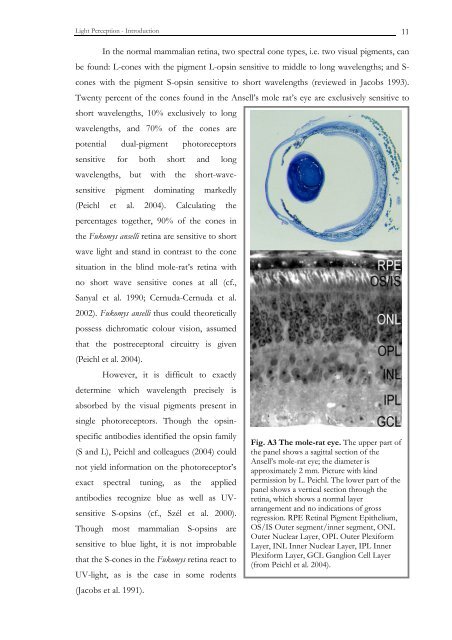Antigen Biotinylated Anti-Rabbit lgs Rabbit Primary Antiserum AB ...
Antigen Biotinylated Anti-Rabbit lgs Rabbit Primary Antiserum AB ...
Antigen Biotinylated Anti-Rabbit lgs Rabbit Primary Antiserum AB ...
You also want an ePaper? Increase the reach of your titles
YUMPU automatically turns print PDFs into web optimized ePapers that Google loves.
Light Perception - Introduction<br />
In the normal mammalian retina, two spectral cone types, i.e. two visual pigments, can<br />
be found: L-cones with the pigment L-opsin sensitive to middle to long wavelengths; and S-<br />
cones with the pigment S-opsin sensitive to short wavelengths (reviewed in Jacobs 1993).<br />
Twenty percent of the cones found in the Ansell’s mole rat’s eye are exclusively sensitive to<br />
short wavelengths, 10% exclusively to long<br />
wavelengths, and 70% of the cones are<br />
potential dual-pigment photoreceptors<br />
sensitive for both short and long<br />
wavelengths, but with the short-wave-<br />
sensitive pigment dominating markedly<br />
(Peichl et al. 2004). Calculating the<br />
percentages together, 90% of the cones in<br />
the Fukomys anselli retina are sensitive to short<br />
wave light and stand in contrast to the cone<br />
situation in the blind mole-rat’s retina with<br />
no short wave sensitive cones at all (cf.,<br />
Sanyal et al. 1990; Cernuda-Cernuda et al.<br />
2002). Fukomys anselli thus could theoretically<br />
possess dichromatic colour vision, assumed<br />
that the postreceptoral circuitry is given<br />
(Peichl et al. 2004).<br />
However, it is difficult to exactly<br />
determine which wavelength precisely is<br />
absorbed by the visual pigments present in<br />
single photoreceptors. Though the opsin-<br />
specific antibodies identified the opsin family<br />
(S and L), Peichl and colleagues (2004) could<br />
not yield information on the photoreceptor’s<br />
exact spectral tuning, as the applied<br />
antibodies recognize blue as well as UV-<br />
sensitive S-opsins (cf., Szél et al. 2000).<br />
Though most mammalian S-opsins are<br />
sensitive to blue light, it is not improbable<br />
that the S-cones in the Fukomys retina react to<br />
UV-light, as is the case in some rodents<br />
(Jacobs et al. 1991).<br />
Fig. A3 The mole-rat eye. The upper part of<br />
the panel shows a sagittal section of the<br />
Ansell’s mole-rat eye; the diameter is<br />
approximately 2 mm. Picture with kind<br />
permission by L. Peichl. The lower part of the<br />
panel shows a vertical section through the<br />
retina, which shows a normal layer<br />
arrangement and no indications of gross<br />
regression. RPE Retinal Pigment Epithelium,<br />
OS/IS Outer segment/inner segment, ONL<br />
Outer Nuclear Layer, OPL Outer Plexiform<br />
Layer, INL Inner Nuclear Layer, IPL Inner<br />
Plexiform Layer, GCL Ganglion Cell Layer<br />
(from Peichl et al. 2004).<br />
11

















